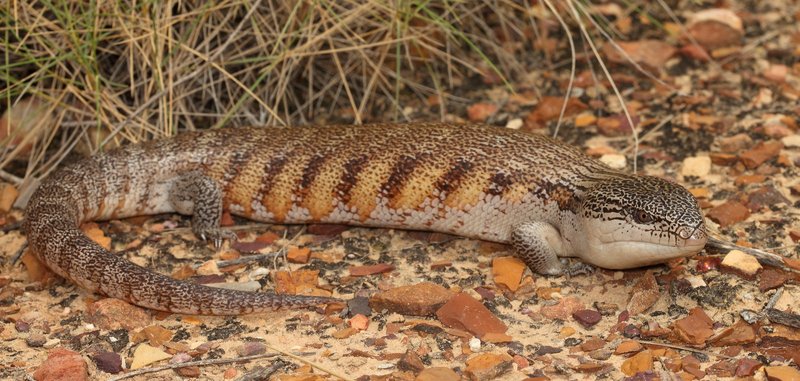
Now, imagine you’re having coffee with a friend who just adopted a blue-tongue skink. They’re excited to share their new pet, but you can’t help but wonder: could this creature pose any risks? Here’s the thing—understanding the potential dangers of any animal is crucial. So, let’s dive deeper into the world of blue-tongue skinks. Are they friendly companions, or do they hold hidden dangers for humans?
What is a Blue-Tongue Skink?
Blue-tongue skinks are fascinating reptiles native to Australia and New Guinea. With their distinctive blue tongues and stout bodies, they have a striking appearance that makes them popular in the pet trade. Typically, these lizards can grow to about 18 to 24 inches long, depending on the species. Their unique coloration and relatively docile nature make them appealing to reptile enthusiasts.
These skinks are primarily herbivorous, munching on leafy greens, fruits, and occasional insects. They often inhabit forests and grasslands, where they find shelter under rocks or logs. Although they can’t change color like chameleons, their blue tongues serve as a defense mechanism. When threatened, they can stick out their tongues, which is enough to startle potential predators. So, right off the bat, you can see that blue-tongue skinks are more than just pretty faces.
Are Blue-Tongue Skinks Venomous?
One of the first questions people ask is, “Are blue-tongue skinks venomous?” Thankfully, the answer is no! These lizards do not possess venom like some snakes do, which is a relief for those who might be worried about dangerous bites. Their primary defense mechanism is their appearance, which can be quite intimidating.
Here’s the thing: even though they won’t inject venom, a blue-tongue skink can bite if provoked. It’s more of a warning than a true attack. If they feel threatened or cornered, they might chomp down, but this is relatively rare, especially in well-socialized pets. The bites tend to be more startling than harmful, causing minor scratches rather than serious injuries.
Handling Blue-Tongue Skinks Safely
If you’re considering getting a blue-tongue skink, it’s essential to understand how to handle them properly. Handling is one part of building trust with your new pet. Here’s a simple step-by-step guide to help you:
- Start Slowly: Allow your skink to acclimate to its new environment for at least a week.
- Approach Gently: When the time is right, approach slowly and let the skink come to you instead of grabbing it.
- Support Its Body: Always support the skink’s body with both hands to give it a sense of security.
- Avoid Sudden Movements: Quick movements can startle your skink and lead to biting.
By following these simple steps, you can minimize stress for both you and your skink. Most blue-tongue skinks will eventually enjoy being handled as they get more comfortable around you, and those interactions can be rewarding for both parties.
Common Myths About Blue-Tongue Skinks
There are plenty of myths surrounding blue-tongue skinks that contribute to their reputation. One common myth is that they’re aggressive and dangerous. The reality is that they are generally docile creatures. They may hiss or puff up when they feel threatened, but this behavior is usually just bluster.
Another misconception is that blue-tongue skinks are prone to diseases that can harm humans. While all animals can potentially carry bacteria, proper hygiene practices can minimize risks significantly. Washing your hands after handling any pet is a good practice, and it helps keep both you and your skink healthy.
Are Blue-Tongue Skinks Safe for Children?
If you have kids and are considering adding a blue-tongue skink to your family, you might be wondering if they’re safe. Generally, blue-tongue skinks make great pets for kids. Their calm temperament and relatively easy care make them a manageable choice for families.
However, supervision is key. Kids should be taught how to handle the skink gently and respectfully. If they understand that sudden movements can cause stress for the lizard, they’re less likely to provoke it. Teaching kids about the needs and behaviors of their new pet will not only keep everyone safe but will also foster a sense of responsibility.
Potential Risks of Blue-Tongue Skinks
While blue-tongue skinks aren’t dangerous, there are still some potential risks to consider. From scratches to allergies, it’s important to be aware of these factors.
First, as mentioned earlier, a bite can happen if the skink feels threatened. Though they’re not venomous, a bite can still be painful and might require a minor clean-up.
Second, some people may experience allergic reactions to reptiles. If you have a history of allergies, it’s wise to spend some time around a blue-tongue skink before making a commitment.
Lastly, keeping a proper habitat is crucial for your skink’s health. Poor living conditions can lead to stress and illness, so it’s vital to maintain a clean environment. By providing a suitable setup, you’re also reducing any risk to yourself.
In summary, blue-tongue skinks are generally not dangerous to humans. They’re primarily peaceful creatures that can make wonderful pets with the right care and handling. Understanding their behavior and needs is essential to fostering a positive relationship with your new scaly friend.
So, if you’re considering adding a blue-tongue skink to your home, do your research. Learn about their habitats, diets, and how to handle them properly. With a little knowledge and patience, you could be on your way to forming a delightful bond with one of nature’s most intriguing reptiles.
